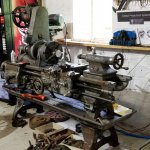rustyjazz1938
Plastic
- Joined
- Jan 7, 2021
Hello All,
I'm new to this forum, but amazed at the breadth of knowledge present, and my hope is to potentially tap into that knowledge. A bit of my background, I'm an engineer in the automotive industry, and my primary hobby is vintage automobiles, however to go with vintage automobiles, there is nothing better than vintage machinery, especially when it comes time to make parts that are made of unobtainium. My current project is king pin and bushing work on a 1914 Studebaker.
On to the machinery side of the discussion. Early in 2020, before the world stopped turning for a bit, I became the proud new owner of a Hendey Cone Head lathe (I believe to be 16in swing). The lathe has had a long hard life as evidenced by the pictures, but frankly its next stop if I did not save it would be the scrapper's torch, and it turns out that even as beat up as it is, the machine still runs great and will suit my needs. An example of its hard life is the conversion to electric drive, which I think was performed in the 1930s based on the original motor (not in use) and speed conversion gear box. To make the multi v-belt drive system work, the brace at the headstock end that covered the flat belt pulleys was butchered (best description of the cuts) off of the machine. That being said, I've successfully put the lathe to use making parts for my cars already, however I am now in need of some of its specifications for the next project. I am hopeful that perhaps Hendeyman can find its history and specs in his archives, or another knowledgeable member can answer my question.
The ways of the machine have been scraped at some point in its life, however I believe I was able to discern the serial number as 12360 (maybe 12330, the number stamp is almost completely gone). If it helps narrow it down, the chip tray it is mounted on has an equipment dealer plate from The Strong, Carlisle & Hammond Co. of Detroit and Cleveland.
The question I have, is that for the upcoming job, I will need to be turning between centers, and I do not have a spindle center for my lathe. Can anyone tell me what taper the spindle accepts so I can begin the search for what I need?
Thanks for any help in advance, for reading my lengthy post,
Rusty Berg




I'm new to this forum, but amazed at the breadth of knowledge present, and my hope is to potentially tap into that knowledge. A bit of my background, I'm an engineer in the automotive industry, and my primary hobby is vintage automobiles, however to go with vintage automobiles, there is nothing better than vintage machinery, especially when it comes time to make parts that are made of unobtainium. My current project is king pin and bushing work on a 1914 Studebaker.
On to the machinery side of the discussion. Early in 2020, before the world stopped turning for a bit, I became the proud new owner of a Hendey Cone Head lathe (I believe to be 16in swing). The lathe has had a long hard life as evidenced by the pictures, but frankly its next stop if I did not save it would be the scrapper's torch, and it turns out that even as beat up as it is, the machine still runs great and will suit my needs. An example of its hard life is the conversion to electric drive, which I think was performed in the 1930s based on the original motor (not in use) and speed conversion gear box. To make the multi v-belt drive system work, the brace at the headstock end that covered the flat belt pulleys was butchered (best description of the cuts) off of the machine. That being said, I've successfully put the lathe to use making parts for my cars already, however I am now in need of some of its specifications for the next project. I am hopeful that perhaps Hendeyman can find its history and specs in his archives, or another knowledgeable member can answer my question.
The ways of the machine have been scraped at some point in its life, however I believe I was able to discern the serial number as 12360 (maybe 12330, the number stamp is almost completely gone). If it helps narrow it down, the chip tray it is mounted on has an equipment dealer plate from The Strong, Carlisle & Hammond Co. of Detroit and Cleveland.
The question I have, is that for the upcoming job, I will need to be turning between centers, and I do not have a spindle center for my lathe. Can anyone tell me what taper the spindle accepts so I can begin the search for what I need?
Thanks for any help in advance, for reading my lengthy post,
Rusty Berg








